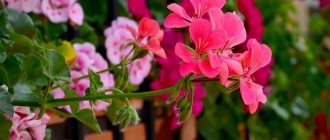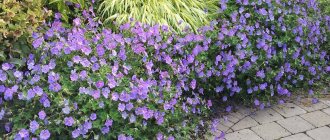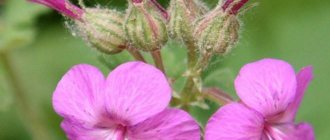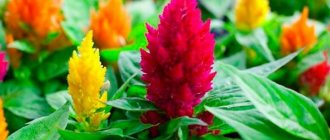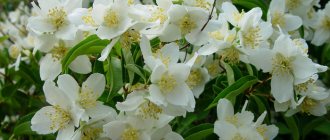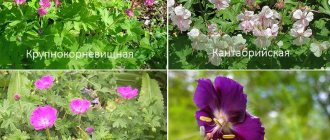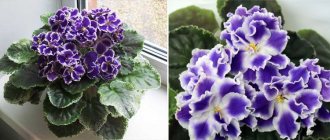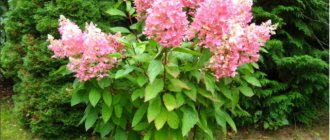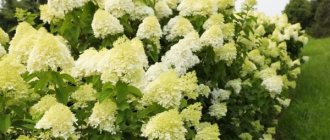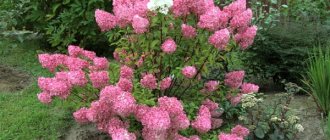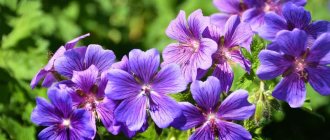Botanical description and history
Ivy geranium belongs to the geranium family, genus - geranium (Geranium) . Its homeland is the southern regions of Africa, where in nature the plant lives on high hills and cascades down the slopes. Therefore, the flower tolerates temporary lack of moisture well and is a heat-loving and light-loving plant.
Geranium ivy or ivy-leaved is an ampelous plant, a subshrub, capable of growing up to 1 m in height. Due to the fact that the shape of the leaves is similar to ivy (five-lobed, fleshy, whole), the plant got its name. The leaf width is from 3 to 6 cm. The color is green, sometimes with veins or a white border.
Star-shaped flowers of various colors and shades . Collected in umbrella inflorescences, the diameter of which can be 8 cm. Large inflorescences can consist of 30 flowers. The average flower size is 1.5-2.5 cm, but more impressive specimens can reach 4 cm.
Application in landscape design
The plant is best suited for planting in a rustic style. Since pelargonium thrives in full sun, Mediterranean herbs are an ideal addition. Red and pink geraniums create an intriguing arrangement with sage, rosemary and blue lavender flowers. For a Mediterranean style, it is worth planting them in terracotta containers. In turn, an idyllic atmosphere can be achieved by planting plants in modest clay pots or wicker baskets. Modern compositions emphasize varieties with white flowers, the color of which should be disrupted by openwork ornamental grasses.
Preparing pelargonium for winter
In October, before the onset of cold weather, I take my pelargonium home for the winter. I pre-cut all the long shoots so they can be rooted again. I don’t fertilize all winter and try to water as little as possible. In indoor conditions, a month after pruning, the plant does not give up - it grows new shoots and throws out new flower stalks with buds.
It’s November, and my clipped pelargonium resembles a flowering fluffy tree rather than a hanging plant, but this new look suits it very well. I have no doubt that by summer it will again grow its long lashes, decorated with umbrellas of inflorescences of snow-white delicate flowers. Her children will also grow up - rooted cuttings, and they, together in a cheerful company, will again go to show off on our country veranda.
Appearance
Ivy geranium flowers come in a wide variety of colors and shades: white, scarlet, red, lilac, pink. In appearance, the inflorescence resembles a peony. The leaves are smooth to the touch, the branches are 70-90 cm long. This plant differs from other types of geranium in its drooping stems and stiffer leaves.
The plant is climbing, easily propagated and blooms for a long time: from spring to late autumn. The inflorescences are voluminous, round in shape. In addition to the beautiful appearance of the flowers, ivy-leaved geranium is also distinguished by its incredible endurance.
Popular varieties with photos
Next in the photo you can see some popular varieties of ivy or ivy-leaved geranium.
Over the past three centuries, breeders have managed to develop many different varieties of ivy-shaped geraniums that feel comfortable at home and outdoors.
"Amethyst"
A very popular variety of ivy geranium used to create flower baskets. This variety branches well and develops quickly , so in summer it is often planted in garden flowerpots, and in winter it is brought indoors. It blooms with large double buds of raspberry and pink shades, similar to roses.
"Dacora Pink"
A plant with large light green leaves is beautiful even when it is not blooming. The flowers are simple, neon pink, consisting of five petals with several veins of red or crimson.
"Marble Sunset"
A compact plant with decorative leaves covered with cream or light green spots. In the sun, the leaves take on a golden or bronze hue . Purple veins are clearly visible on the petals.
The variety is very capricious, so it is not popular in home gardening.
"Ise Rose"
This plant resembles a bush rose . The buds are white with a slight greenish tint. Blooms thickly and for a long time. In bright sun, the flowers may take on a lilac hue.
"Rouletta"
This variety of ivy-shaped geranium is used for planting in large flower pots, both indoors and in gardens. Small bush with short internodes. The stems branch weakly and bloom profusely with simple white flowers with small pink specks and a crimson border on the petals.
"Tornado Fuchsia"
A lush variety of climbing geranium with rich green foliage. The shape of the flower resembles the wings of a butterfly . The flowers are lilac-colored with spots and veins. This variety creates beautiful compositions for the street; the plant grows quickly, and with proper care it blooms for a long time.
Blooming ivy-leaved pelargonium
Ivy-leaved pelargoniums have slightly smaller flowers than other species but bloom profusely.
Depending on the inflorescences, they can be single, semi-double or complete. They are collected in umbrellas on long stems growing from the axils of the leaves. Forms of ivy-leaved pelargonium with semi-double and full flowers are characterized by a compact appearance and shorter shoots than those of single ones. Both look very impressive in planters, creating hanging garlands on the balcony in colors of pink, red, white, lilac, purple or multi-colored. My beauty blooms with very delicate double white flowers, while caring for them I encountered an amazing phenomenon. When the flowers had already faded and dried up, became yellow and withered, I wanted to cut off the peduncle, but then I discovered that new buds were preparing to open on the same peduncle - the second wave of flowering. That's why I haven't touched the flower stalks since then - I leave them whole, picking off only the withered flower petals.
With the onset of the summer dacha season, my pelargonium moved into a hanging container, which I placed on the veranda of the dacha house. This is how the ampelous beauty decorated our dacha until the coldest weather. Over the summer, she grew quite long vines, so in August I decided to shorten them a little, and at the same time try to propagate the plant - after all, there is never too much beauty.
Fertilizer
This flower requires more intensive feeding than other flowers for the balcony. To ensure that it blooms beautifully throughout the season, we feed it with fertilizers specially selected for the needs of this species. For example, Florovit or Fructus for pelargonium. Ivy-leaved pelargonium blooms until autumn, so when growing it, you should also feed the plants with special nutrients for autumn flowers. Liquid supplements are usually used once a week or every two weeks.
If you are going to store hanging geraniums for the winter, you need to fertilize the plants in August.
Recommended for you:
- Pelargonium ivy-leaved
- Pelargonium red - how to care
- Pelargonium zonal
- Pelargonium cultivation and care
Where and how to plant it: rules and tips, instructions
Hanging flowerpots, baskets, and boxes on balconies are most suitable for planting geraniums. This light-loving plant should be placed on the sunny side. It also looks beautiful and harmonious on the facades of houses. And if you plant this type of geranium on a flat area, the plant will create a dense flowering carpet.
Prepare seedlings in spring or early autumn. To decorate the balcony, rooted plants are planted in boxes in one row, at a distance of 15 cm from each other.
Young plants must be regularly watered and fed with mineral fertilizer, which is applied in small portions.
Lighting and location
Ivy geranium prefers the sunny side, so it is better to place a flowerpot with a plant on a south-east or south-west window in the room. It feels great outdoors and even on hot summer days the plant does not wither and continues to bloom. But if geranium grows in partial shade, then you may not see its abundant flowering.
Soil requirements
Ampelous geranium is not demanding on the soil, however, for successful growth and development of the bush, the soil must be loose and well-drained . The following compositions can be used:
Universal soil for indoor plants is mixed with perlite, river sand and vermiculite in equal proportions (perlite and vermiculite can be replaced with humus and peat).- Soil from the garden, taken from under bushes or trees, is suitable.
- 8 parts turf soil, 2 parts humus, 1 part river sand.
- In equal proportions: turf, leaf soil, peat and sand.
Ivy geranium also feels comfortable in a loose nutritious substrate , to which a little clay is added.
Read more about growing ivy or ivy-leaved geraniums at home in a separate article.
Is it possible to grow not only at home, but also outdoors?
Separately, it is worth mentioning about growing geraniums outdoors. In order for the plant to grow not indoors, but outdoors, it must be prepared. To do this, in the spring, containers with flowers begin to gradually be placed outside for a while, while avoiding sub-zero temperatures. After frost, geraniums can be placed outside in the summer.
Closer to autumn, when the temperature begins to drop below 10°C, it is recommended to take geraniums indoors. At the same time, they are provided with special conditions - a bright and cool place, a temperature of 7-10°C, and a reduction in watering. During the off-season, the plant can overwinter on windowsills .
Ampelous geranium is an incredibly beautiful plant that, with proper care, can become a real addition to the interior and delight with cascades of climbing flowers not only during the flowering period, but also in winter. It does not require special care and is quite easy to maintain, which is why it is in demand among gardeners in many countries.
How to properly care?
In order for ivy-leaved geranium to feel comfortable, it needs to create favorable conditions:
- Water the flower in hot weather often, but in small portions. In winter, watering should be reduced to 2-3 times a month and ensure that water does not get on the leaves.
- In spring and summer, feed with phosphorus and potassium fertilizers three times a month. Magnesium sulfate will also be useful for climbing geraniums - it promotes long-term flowering, but nitrogen fertilizers reduce the flowering of the plant.
- At the end of February, geraniums are pruned and shoots are pinched - this will promote tillering and more abundant flowering.
- The plant is replanted once every two years in the spring; the pot should not be too large.
Good to know! Ivy-leaved geranium tolerates replanting well at any age.
You can learn more about caring for ivy-leaved geraniums here.
Caring for ivy-leaved pelargonium
Ivy-leaved pelargonium is very unpretentious to grow. Unlike ivy, which it looks so much like at first glance, it does not like high humidity and does not tolerate spraying. The “ivy leaf” should be planted in a container with good drainage, with light, fertile soil without excess nitrogen; the watering regime should be moderate - as the soil dries out. Pelargonium is very responsive to regular feeding; it needs potassium for abundant flowering. It is better to grow the plant in a sunny place, especially since it is not at all afraid of direct sunlight. The basic rule for them is the more sun, the more flowers.
Common diseases and pests
The plant may be attacked by pests:
- Thrips - appear in the form of growths on the back of the leaf, which leads to their deformation and the appearance of spots on the flowers.
- Mites often infest the edges and appear as yellow speckles on the leaves and can cause them to wilt. The appearance of ticks is provoked by heat and dry air.
- If curled, yellowed leaves appear on the plant, it means that aphids have settled on it.
The most dangerous disease of ivy geranium is blackleg. This disease is very difficult to fight, therefore, it is better to destroy such a plant so that the disease does not spread to other flowers.
Features of reproduction
Propagated by cuttings and seeds. Propagation of ivy geranium by cuttings:
- In spring, cut off the upper part of vertical shoots 7-10 cm long, preferably with four healthy leaves.
- Dry the cuttings, sprinkle the cut areas with charcoal powder and plant them in loose soil to a depth of 3-4 cm for rooting.
- The first watering should be plentiful, and all subsequent watering should be moderate.
- When the roots appear, the geranium is transplanted to a permanent place in prepared pots with soil.
Attention! For successful rooting and growing of climbing geraniums, it is necessary to maintain an ambient temperature of 20 to 22 degrees.
Geranium seeds can be sown from April to November.
- The soil for seeds should be loose and light. To do this, you can mix universal soil, peat and coarse sand.
- The seeds are deepened by half a centimeter, covered with film, periodically opening and spraying the ground with a spray bottle.
They produce excellent seedlings, but in winter additional lighting is necessary , since daylight hours must be at least 12 hours.
Unpretentious, brightly blooming ivy-shaped geraniums look incredibly beautiful in hanging flowerpots and can decorate a corner of any garden or room. In Europe, climbing geranium is used for landscaping arched structures. With proper care, this plant can bloom for six months without interruption.
Who doesn't know geranium? This beautiful and fragrant flower can often be seen in a flowerbed or loggia. But does everyone know how many species and varieties of this plant there are? We have prepared a number of separate articles from which you can learn about the white and black varieties of geranium, about rosebud, royal and tulip-shaped, about the varieties Rosanna and Angel, the amazing Peony and the beautiful Roberta.
